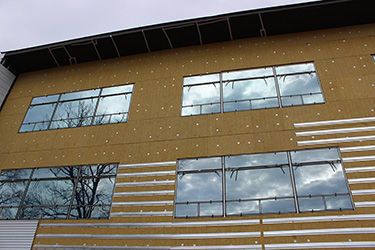|
Subscribe / Renew |
|
|
Contact Us |
|
| ► Subscribe to our Free Weekly Newsletter | |
| home | Welcome, sign in or click here to subscribe. | login |
Architecture & Engineering
| |
 |
October 26, 2017
Rock wool’s new role: protecting exterior wood stud walls
Code Unlimited

Paul
|
While the 1960s ushered in political and cultural revolutions, old consumer advertising methods were still booming from the 50s. Products like asbestos, Spam and Lucky Strikes were accepted into American homes, offices and even airplanes.
Today, although most of these direct-to-consumer products have fallen by the wayside, many of the building materials in our homes and workplaces are still the same as they were half a century ago.
In building code and fire protection consulting, our engineers and analysts deal with these types of materials every day. Our principal fire protection engineer, Franklin Callfas, is a father of three and the impacts of those products weigh heavily on his mind.
“Fire protection suppression chemicals and treatments have the potential to be released into the environment; but these are the current prescriptive options available to meet codes,” Callfas said.
In code consulting, some of the other issues dealt with are performance-based alternates and appeals to local jurisdictions.
Recently, we developed an alternate method we consider a revolution in sustainable building practices: using nontoxic mineral wool insulation with standard wood studs in exterior framed walls. By appealing to local jurisdictions, this alternate can foster healthy changes in building practices by replacing the older products accepted by previous generations.
The code allows this alternative material to be used through appeals and engineering judgment letters, something Code Unlimited facilitates. This new method of protecting wood with mineral wool (aka rock wool) can save thousands in construction costs, reduce chemical footprints and provide better protection than previously approved products.
Partnered with some of our best clients, we have successfully appealed to code officials to allow the use of this product in several Type III construction projects.
Despite not being adopted into large-scale code regulations yet, this alternate has been difficult for local jurisdictions to deny. Let’s take a look at the facts:
• Rock wool has an increased fire rating compared to the alternatives, with a melting point of 2,150 degrees F. Our analysis found that the fire performance of rock wool insulation is equal or superior to the alternatives and actually adds substantial fire resistance.
• The International Building Code already permits the use of rock wool as a means to delay ignition or fire and flame migration. So ultimately, we are using an already proven product. To put it simply, rocks don’t burn.
• Currently accepted fire protection chemicals are water soluble and can decrease in effectiveness over time. Rock wool can get wet and ages without any deterioration because it’s made from rocks. So the protection of the structure is infinite.
• Deterioration is also a factor when taking into consideration how fire-retardant chemicals break down and corrode other building materials, which can lead to additional costs and construction concerns, including structural strength and capacity. Again, these chemicals are not an issue when using rock wool.
• Premium pricing of older products can be avoided with the much more affordable rock wool.
• Ease of use and storage of rock wool results in reduced hourly wage and related costs.
• Rock wool is made from the byproducts of other materials, therefore allowing the creative re-use of an otherwise waste material. In fact, rock wool is 70 percent recycled content.
• Rock wool is a substitute for current code-approved fire protection products that introduce chemicals into the construction such as boric acid and formaldehyde. The impacts of our extensive use of these chemicals on human health and the environment are yet to be fully discovered, however per the MSDS sheets, the chemicals are considered carcinogenic.
• As an insulation type, rock wool has a higher rating for weather protection than other forms of insulation and is already being used extensively because of its efficiency in lowering heating and cooling costs.
Rock wool insulation has been accepted for use in building construction for decades. The alternate use we are introducing is only revolutionary in its application for fire protection in combustible wood structures. Through analysis, we have been able to prove an equal or greater fire and life safety protection method than the current accepted industry standards.
The financial and environmental benefits only further our reasoning to support these types of alternates and products.
As consumers, it is our job to advocate for the products we want to use in building a better world. The 1960s created precedence for change to be driven by the end user. Our current challenge is the application of those changes to the construction industry.
Gone are the days of Vietnam and bell bottom jeans. Smoking is now prohibited within 10 feet of most buildings. Isn’t it time we move towards clean air inside of those buildings as well?
Vickie Paul handles marketing and recruiting efforts for Code Unlimited, a building and fire code consulting firm for architects, engineers and owners.
Other Stories:
- Ice Box Challenge: a cool test of Passive House
- Survey: Code Unlimited
- Survey: IA Interior Architects
- Surveys: NAC Architecture
- Survey: AHBL
- Survey: Lemons Architecture
- Is growth only benefiting a small segment in Seattle?
- Get ready for the new year — and new energy codes
- After 10-year engagement, Kinects inverts ‘wedding cake’
- WSU cultural center: ‘How are you going to build this?’
- High-performance building? Start with early design analysis
- How ‘affordable’ housing is disappearing in Seattle
- How long will your AV last? Consider your cell phone
- Survey: Arup



